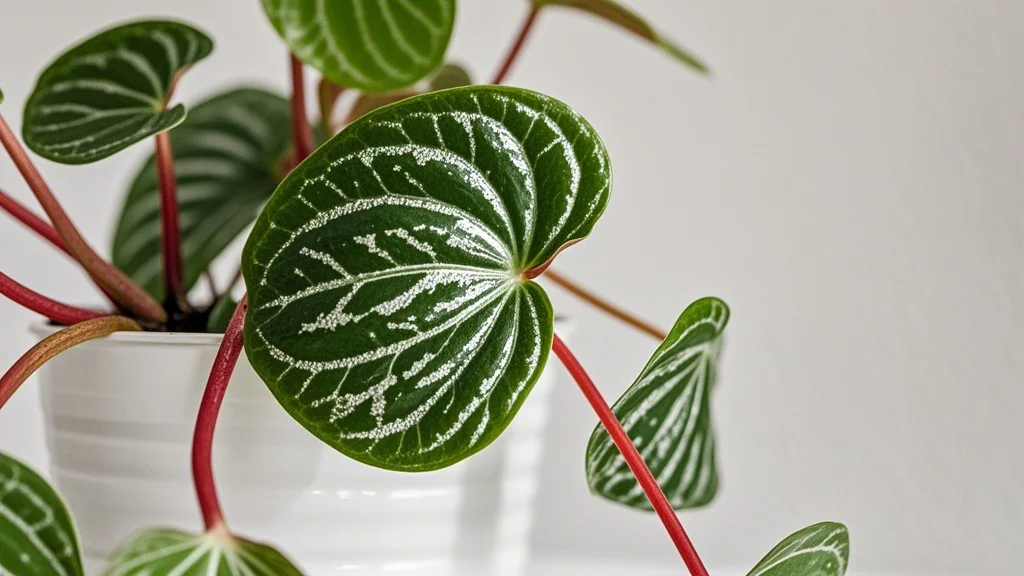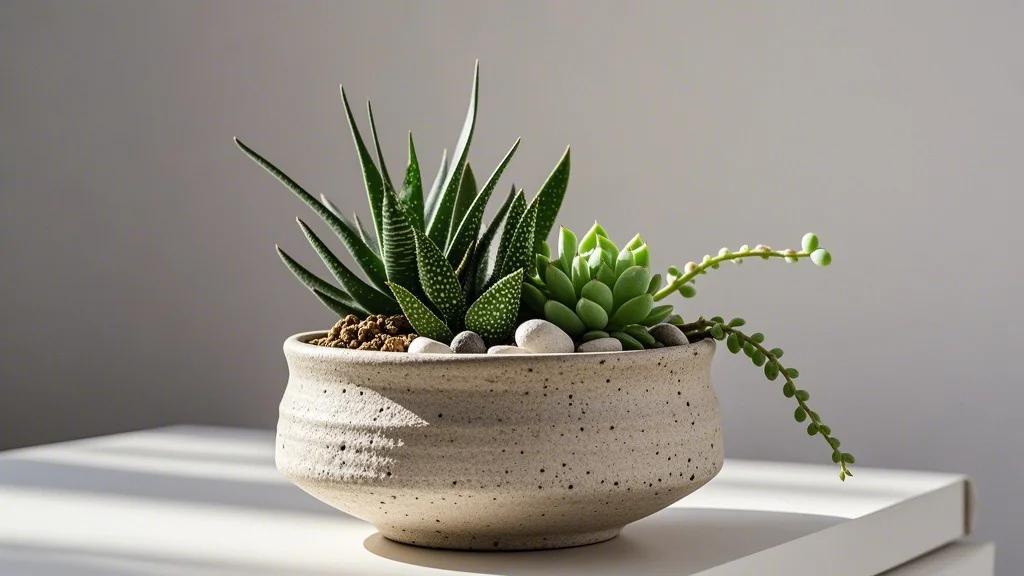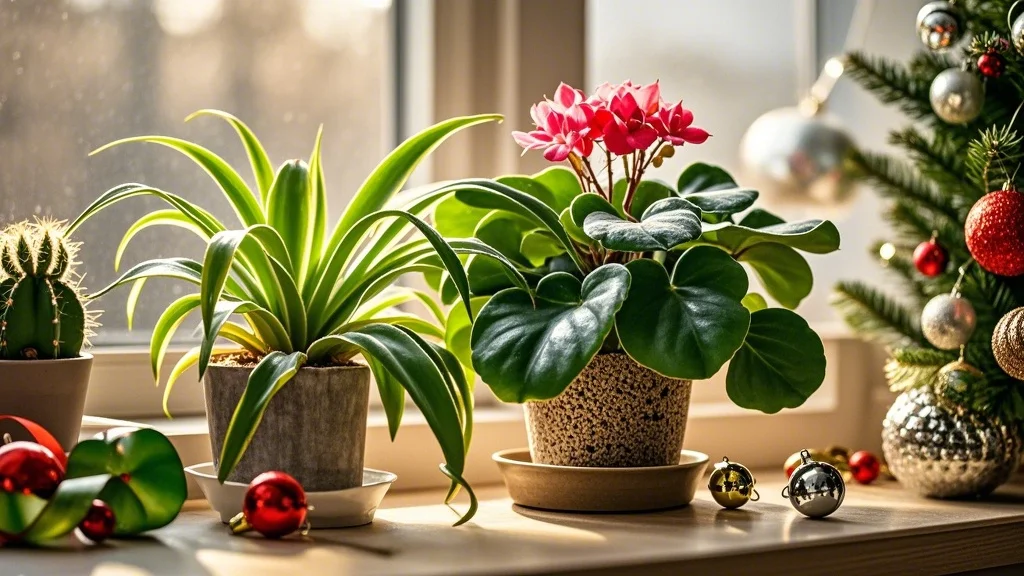For plant enthusiasts who share their homes with furry companions, finding beautiful houseplants that won’t harm pets can be challenging. Peperomia plants offer the perfect solution—a vast genus with over 1,000 species that combine striking diversity with pet-safe properties. These compact treasures from tropical and subtropical regions have become favorites among collectors for their varied leaf shapes, colors, and textures, all while remaining non-toxic to cats and dogs.
Contents
- 1 Why Peperomia Plants Are Perfect for Pet Owners
- 2 Popular Peperomia Varieties for Collectors
- 2.1 Watermelon Peperomia (Peperomia argyreia)
- 2.2 Ripple Peperomia (Peperomia caperata)
- 2.3 Raindrop Peperomia (Peperomia polybotrya)
- 2.4 String of Turtles (Peperomia prostrata)
- 2.5 Ruby Glow Peperomia (Peperomia graveolens)
- 2.6 Peperomia Hope (Peperomia rotundifolia × quadrifolia)
- 2.7 Baby Rubber Plant (Peperomia obtusifolia)
- 2.8 Peperomia Rosso (Peperomia ‘Rosso’)
- 3 Care Tips for Thriving Peperomias
- 4 Propagation: Expanding Your Collection
- 5 Common Issues and Solutions
- 6 Creating Stunning Peperomia Displays
- 7 Conclusion
Why Peperomia Plants Are Perfect for Pet Owners
Peperomia plants have earned their place on the ASPCA’s list of non-toxic plants, making them ideal choices for households with curious pets. Unlike many popular houseplants that contain harmful compounds, peperomias don’t produce toxic substances that could harm cats, dogs, or other pets if accidentally ingested.
Beyond their pet-friendly nature, these plants offer several advantages:
- Compact size: Most varieties remain small, rarely exceeding 12 inches in height
- Low maintenance: Tolerant of occasional neglect and varying light conditions
- Diverse appearances: From rippled leaves to trailing vines, there’s a peperomia for every aesthetic
- Air-purifying qualities: Help improve indoor air quality while adding visual interest
Popular Peperomia Varieties for Collectors
Watermelon Peperomia (Peperomia argyreia)

The Watermelon Peperomia earns its name from its distinctive oval leaves with silvery stripes resembling watermelon rind. This striking variety features:
- Thick, fleshy leaves with a slight sheen
- Reddish-purple stems that create beautiful contrast
- Compact growth habit, typically reaching 6-8 inches tall
- Preference for bright, indirect light
This variety makes an excellent tabletop specimen and thrives in moderate humidity, making it suitable for most home environments.
Ripple Peperomia (Peperomia caperata)
Known for its deeply textured, heart-shaped leaves, the Ripple Peperomia offers dramatic visual interest:
- Deeply corrugated, rippled leaf surface
- Available in various colors including red, burgundy, green, and silver
- Compact, mounding growth habit
- Delicate flower spikes resembling rat tails
Popular cultivars include ‘Emerald Ripple’, ‘Red Ripple’, and ‘Silver Ripple’, each offering unique coloration while maintaining the characteristic textured foliage.
Raindrop Peperomia (Peperomia polybotrya)
The Raindrop Peperomia features glossy, teardrop-shaped leaves that resemble raindrops:
- Thick, succulent-like foliage with a glossy finish
- Bright green coloration with lighter green undersides
- Upright growth habit reaching 8-12 inches tall
- Bushy appearance when mature
This variety stores water in its fleshy leaves, making it somewhat drought-tolerant and forgiving of occasional missed waterings.
String of Turtles (Peperomia prostrata)

This delicate trailing variety has become increasingly popular among collectors:
- Tiny round leaves with intricate turtle shell-like patterns
- Trailing stems perfect for hanging baskets or shelf displays
- Slow-growing nature that prevents it from becoming unmanageable
- Preference for bright, indirect light
The String of Turtles adds textural interest to any collection and pairs beautifully with other small-leaved trailing plants.
Ruby Glow Peperomia (Peperomia graveolens)
This succulent-like peperomia offers striking color contrast:
- V-shaped, fleshy leaves with red undersides
- Gray-green upper leaf surfaces
- Semi-trailing growth habit
- Preference for bright light to maintain vibrant coloration
The Ruby Glow requires less frequent watering than many other peperomias, making it suitable for forgetful plant parents.
Peperomia Hope (Peperomia rotundifolia × quadrifolia)
This charming hybrid combines the best features of its parent plants:
- Small, round, succulent-like leaves arranged in groups of three or four
- Trailing growth habit ideal for hanging displays
- Silvery-green coloration
- Excellent drought tolerance
Peperomia Hope’s trailing nature makes it perfect for hanging baskets or as a spiller in mixed arrangements.
Baby Rubber Plant (Peperomia obtusifolia)
One of the most common and robust peperomia varieties:
- Thick, glossy, spoon-shaped leaves
- Upright growth habit reaching 6-12 inches tall
- Available in variegated forms with cream or white markings
- Excellent tolerance for lower light conditions
The Baby Rubber Plant’s resilience makes it perfect for beginners while its attractive foliage appeals to collectors.
Peperomia Rosso (Peperomia ‘Rosso’)
This distinctive cultivar offers dramatic coloration:
- Pointed, lance-shaped leaves with deeply ridged surfaces
- Dark green upper leaf surfaces with deep red undersides
- Compact growth habit rarely exceeding 8 inches
- Striking appearance when backlit
Peperomia Rosso requires slightly more consistent moisture than some other varieties but rewards with its dramatic appearance.
Care Tips for Thriving Peperomias
While specific varieties may have unique requirements, most peperomias share similar care needs:
Light Requirements
Most peperomias thrive in medium to bright indirect light. While they can tolerate lower light conditions, their growth may slow and variegated varieties may lose their distinctive patterns. Avoid direct sunlight, which can scorch their leaves.
For optimal growth:
- Place near east or west-facing windows
- Filter strong southern exposure with sheer curtains
- Supplement with grow lights in darker spaces
Watering Practices
Peperomias store water in their fleshy leaves and stems, making them somewhat drought-tolerant. Their biggest enemy is overwatering, which can quickly lead to root rot.
For healthy plants:
- Allow the top 1-2 inches of soil to dry out between waterings
- Reduce watering frequency during winter months
- Water from below when possible to avoid wetting the crown
- Use pots with drainage holes to prevent water accumulation
Soil and Potting
These plants prefer well-draining soil that prevents water from becoming stagnant around their roots:
- Use a mix of regular potting soil, perlite, and orchid bark
- Commercial cactus or succulent mixes often work well
- Choose small pots as peperomias prefer to be slightly root-bound
- Repot only when necessary, typically every 2-3 years
Humidity and Temperature
While many peperomias originate from humid tropical environments, most adapt well to average household humidity levels:
- Maintain humidity between 40-50% for optimal growth
- Group plants together to create humidity microclimates
- Use pebble trays for varieties requiring higher humidity
- Keep temperatures between 65-80°F (18-27°C)
- Protect from cold drafts and sudden temperature changes
Fertilization
Peperomias are light feeders that don’t require frequent fertilization:
- Apply a balanced, water-soluble fertilizer at quarter-strength monthly during spring and summer
- Skip fertilization during fall and winter when growth naturally slows
- Flush the soil occasionally to prevent fertilizer salt buildup
Propagation: Expanding Your Collection
One of the joys of collecting peperomias is how easily most varieties propagate, allowing you to expand your collection or share with fellow plant enthusiasts:
Leaf Cutting Propagation
For varieties with substantial leaves like Watermelon Peperomia or Baby Rubber Plant:
- Select a healthy, mature leaf with a portion of stem attached
- Cut the leaf in half horizontally (across the leaf)
- Insert the cut edge into moist propagation medium
- Keep humidity high using a clear cover or plastic bag
- Watch for new growth to emerge from the cut edge within 4-6 weeks
Stem Cutting Propagation
For trailing varieties like String of Turtles or Peperomia Hope:
- Take 2-3 inch stem cuttings with several leaves attached
- Remove leaves from the bottom portion of the stem
- Place in water or directly into moist propagation medium
- Maintain high humidity until roots develop
- Transfer to soil once roots reach approximately 1 inch long
Common Issues and Solutions
Even these relatively trouble-free plants can occasionally experience problems:
Yellowing Leaves
- Cause: Usually indicates overwatering or poor drainage
- Solution: Reduce watering frequency, ensure proper drainage, and check for root rot
Brown Leaf Tips
- Cause: Low humidity or mineral buildup from tap water
- Solution: Increase humidity and use filtered or distilled water
Leggy Growth
- Cause: Insufficient light causing plants to stretch
- Solution: Move to a brighter location or supplement with grow lights
Pest Problems
While generally pest-resistant, peperomias can occasionally attract:
- Mealybugs: Treat with insecticidal soap or neem oil
- Spider mites: Increase humidity and treat with miticide if necessary
- Fungus gnats: Allow soil to dry thoroughly between waterings and use sticky traps
Creating Stunning Peperomia Displays
The diverse nature of peperomia varieties allows for creative display options:
Terrarium Gardens
The compact size and humidity tolerance of many peperomias make them ideal terrarium subjects:
- Pair Peperomia prostrata with other small-leaved plants
- Use Ripple Peperomia as a colorful focal point
- Layer different varieties for textural interest
Dish Gardens
Create miniature landscapes using different peperomia varieties:
- Combine upright forms like Peperomia obtusifolia with trailing types
- Use contrasting leaf colors and textures for visual interest
- Add small decorative elements like polished stones or miniature figurines
Living Wall Installations
The shallow root systems of peperomias make them excellent candidates for vertical gardens:
- Mix varieties with different growth habits and colors
- Include other pet-safe plants like ferns and air plants
- Create patterns using variegated and solid-colored varieties
Conclusion
Peperomia plants offer the perfect combination of collector appeal and pet safety. Their incredible diversity in leaf shape, color, and texture ensures there’s a variety to suit every aesthetic preference, while their compact size and adaptability make them suitable for various growing environments. Whether you’re a beginning plant parent or an experienced collector, these charming plants deserve a place in your home—providing beauty and interest without posing risks to your furry companions.
By exploring the world of peperomias, you can build a varied, visually stunning plant collection that remains completely pet-friendly. From the watermelon-patterned leaves of Peperomia argyreia to the delicate trailing stems of String of Turtles, these fascinating plants prove that you don’t have to compromise on style to maintain a safe environment for your pets.









